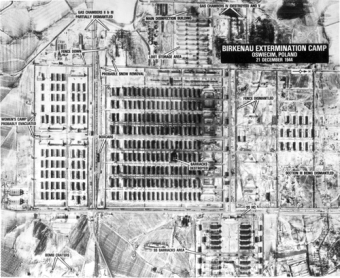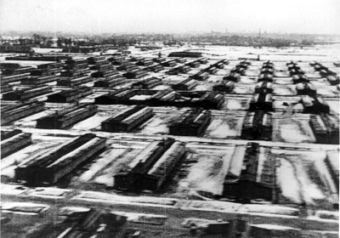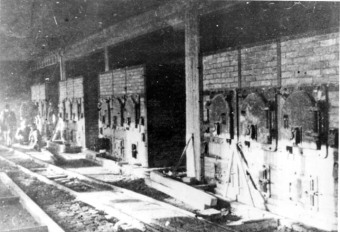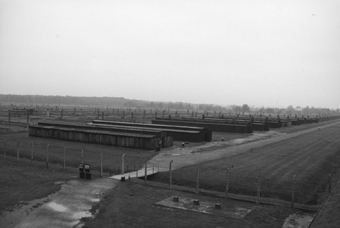Auschwitz II (Birkenau)

© National Archives, Washington, DC

© National Archives, Washington, DC

© National Archives, Washington, DC

© Matthias Naumann
After visiting the Auschwitz concentration camp on March 1, 1941, Reichsführer-SS and Chief of the German Police Heinrich Himmler issued orders for the expansion of the camp, among other things. The Polish population of the surrounding villages was displaced. Starting in October 1941, more than 10,000 Soviet prisoners of war were forced to build a “prisoner of war camp” 3 km (1 mile) from the Auschwitz I main camp. The camp was built on the terrain of the village of Brzezinka (Birkenau). By early March 1942, more than 9,000 Soviet POWs had died of hunger, cold, and epidemic disease while constructing the camp. Originally planned as a POW camp and later referred to as “Birkenau,” the camp was located in an off-limits area of about 40 km² (24 square miles). Initially it was to have a capacity of 100,000, but in the long run it was intended to house 200,000 prisoners. After extensive expansion of the camp, about 140,000 inmates were crowded into the Auschwitz-Birkenau concentration and extermination camp by 1943, and living in catastrophic conditions.
The Birkenau was first subdivided into the mens’ camp (BIb) and the womens’ camp (BIa), for which construction began in August 1942. In 1943, Birkenau was substantially enlarged. The following camps were created:
The “gypsy camp” (BIIe), where more than 22,000 people (men, women, and children) were packed together from late February 1943 until the camp’s dissolution in early August 1944. Thousands of Sinti and Roma died of hunger and disease. During the “liquidation” of the camp in the early part of August 1944, approximately 3,000 camp inmates were gassed.
The “Theresienstadt family camp” (BIIb), in which women, men, and children from the Theresienstadt concentration camp/ghetto were housed from early September 1943 on. After six months, the SS was ordered by the Reich Security Main Office (RSHA, Reichssicherheitshauptamt) to kill the people who had been deported to Birkenau in September 1943. A second “liquidation” of the family camp took place on July 10 and 11, 1944. The camp management selected Jews who were “fit for work” and placed them in so-called reichsdeutsche (“Imperial German”) concentration camps. Thousands of inmates of the family camp were murdered in the gas chambers.
Other camps that were part of Birkenau were the so-called quarantine camp (BIIa), in which new arrivals (Zugänge, “admissions”) were lodged temporarily; the men’s camp (BIId); the prisoner infirmary camp (BIIf); and the camp sector known as “Mexico” (BIII), where Jewish women from Hungary had to live in the worst possible conditions as of summer 1944.
After the dissolution of the extermination camps built in occupied Poland (Generalgouvernement)—Bełzec (March 1943), Treblinka (August 1943), and Sobibór (October 1943)—Auschwitz-Birkenau became the center of the Nazis’ mass extermination program. After January and June 1942, respectively, two converted farm shacks (termed Bunkers 1 and 2) were used for gassing prisoners with Zyklon B. Four large crematoriums with gas chambers and undressing rooms became operational between March and June 1943. The underground gas chambers for Crematoriums II and III, with an area of 210 square meters (about 689 square feet), could hold around 2,000 victims. Crematoriums IV and V had smaller gas chambers—three and four, respectively—with somewhat less “intake capacity.” The Central Building Administration of the Waffen-SS at Auschwitz had the Erfurt firm Topf & Söhne install combustion furnaces in the four crematoriums to incinerate the corpses. There were five combustion furnaces in Crematoriums II and III, each with three combustion chambers, while Crematoriums IV and V had one oven apiece, with eight combustion chambers in each.
In addition to the Jewish deportees who were selected upon arrival, prisoners from the Auschwitz, Birkenau, and Buna/Monowitz camps and the surrounding subcamps who were no longer able to work and had fallen victim to the camp, block, and infirmary selections were “transferred to Birkenau” and gassed there.
Prisoners who were assigned to the special detachment (Sonderkommando) had to pry out the gold teeth of the dead before the bodies were burned in large open pits or in the crematoriums. In addition, the hair of the women’s corpses was cut off, and an SS-run firm, Deutsche Ausrüstungswerke (German Armament Works), made it into blankets.
Against all the odds, there existed a resistance movement in Auschwitz. Partially with the help of the camp resistance, prisoners in the special detachments at Crematoriums II and IV staged an uprising on October 7, 1944. The spontaneous and unorganized rebellion was a failure. The rebels’ plans to destroy the extermination facilities and to escape did not succeed. Two camp guards died and 12 SS men were injured in the revolt. At least 425 members of the special detachments were killed.
On January 18, 1945, the SS forced the 30,000 surviving prisoners of Auschwitz I and Birkenau to go on the death march. Only 7,000 inmates abandoned in the two camps were liberated by the Red Army on January 27, 1945.
(FS; transl. KL)
















